Estado de Sonora $5 notes
(This section is the result of research by Robert Perigoe. This information originally appeared in the December 2011 issue of the Journal of the U. S. Mexican Numismatic Association.)
As was the case for the $1 note, the easiest way to distinguish the plate position for the $5 note is to examine the back of the note. In this case, however, there was a slight change in the back of the notes after Series 1 that remained the same for the last three series.
First Series
A single setting was used for 50 runs of 100 sheets with three positions each for a total of 15,000 notes. The ink used for the mountain seal is vermilion. In subsequent series, it is carmine.
Position 1 (top row): mountain seal type 3, large eagle seal (normal ‘C’), thick block ‘No.’, and serial numbering pattern 1-100, 301-400 …14701-14800. On the back, the dot in ‘SONORA’ is a vertical rectangle, and both uprights of the left ‘$’ extend beyond the ‘S’, although the bottom right extension is short and faint.
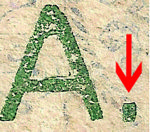 |
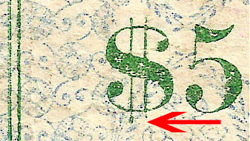 |
Position 2 (middle row): mountain seal type 5, large eagle seal (broken ‘C’), thin block ‘No.’, and serial numbering pattern 101-200, 401-500 …14801-14900. On the back, the dot in ‘SONORA’ is small and irregular in shape, and both uprights of the left ‘$’ are truncated at the top.
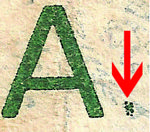 |
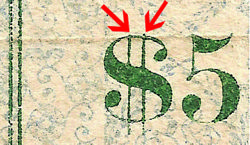 |
Position 3 (bottom row): mountain seal type 4, small eagle seal (with spot), thick fancy ‘No.’, and serial numbering pattern 201-300, 501-600 …14901-15000. On the back, the dot in ‘SONORA’ is a horizontal rectangle, and the left upright of the left ‘$’ is truncated at the bottom.
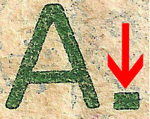 |
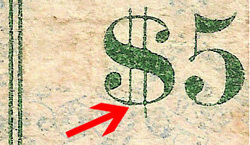 |
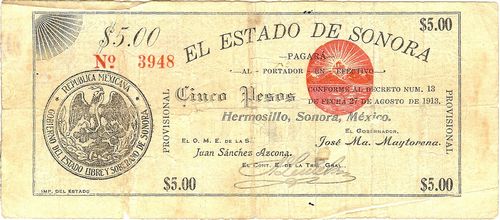 M3816a $5 El Estado de Sonora - 1st Series
M3816a $5 El Estado de Sonora - 1st Series
Position 1
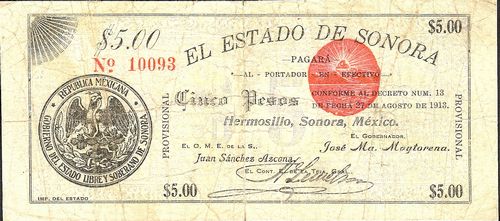 Position 2
Position 2
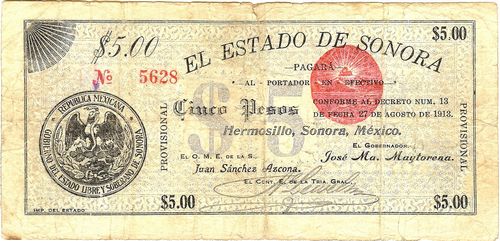 Position 3
Position 3
| Lettering | Mountain seal Type |
State seal Type | |
| Top row | Thick Block | 3 | Large - normal 'C' |
| Middle row | Thin Block | 5 | Large - broken 'C' |
| Bottom row | Thick Fancy | 4 | Small - with spot |
Second series
The printing of this issue is fairly complicated. There are four different settings, entailing errors in serial numbering, corrections, and noticeable wear on the plates. At least one replacement note was produced in this series.
The first setting was used for one run of 100 sheets of three positions each. The numbering pattern is normal. Some print wear is evident on position 1 with a broken ‘a’ in ‘Juan’. This wear is found through the entire series.
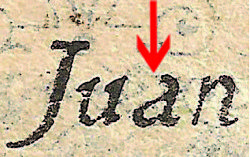
Position 1 (top row): mountain seal type 3, large eagle seal (broken ‘C’), thick block ‘No.’, and serial numbering pattern 1-100. On the back, the dot in ‘SONORA’ is a vertical rectangle. The left upright of the left ‘$’ is truncated at the bottom, and both uprights of the right ‘$’ are truncated at the top.
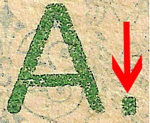 |
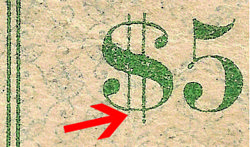 |
|
 |
||
Position 2 (middle row): mountain seal type 5, large eagle seal (normal ‘C’), thin block ‘No.’, and serial numbering pattern 101-200. On the back, the dot in ‘SONORA’ is round and much lower than the adjacent letters, and both uprights of each ‘$’ are complete.
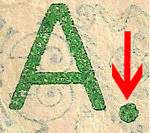 |
Position 3 (bottom row): mountain seal type 4, small eagle seal (with spot), thick fancy ‘No.’, and serial numbering pattern 201-300. On the back, the dot in ‘SONORA’ is a vertical rectangle, and both uprights of each ‘$’ are complete.
 |
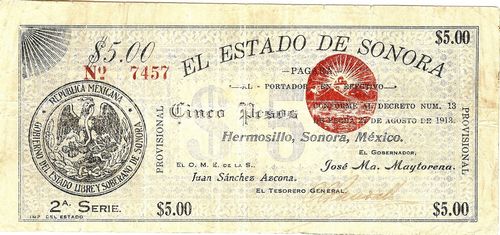 M3816b $5 El Estado de Sonora - 2nd Series
M3816b $5 El Estado de Sonora - 2nd Series
Position 1
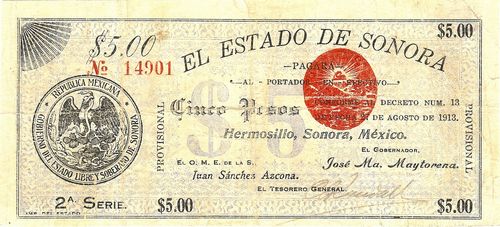 Position 3
Position 3
| Lettering | Mountain seal Type |
State seal Type | |
| Top row | Thick Block | 3 | Large - broken 'C' |
| Middle row | Thin Block | 5 | Large - normal 'C' |
| Bottom row | Thick Fancy | 4 | Small - with spot |
The second setting started with an error in its first run. The serial numbers of the bottom row of the first setting were repeated in the top row of the first run of the second setting, thereby creating an offset numbering pattern for all of the notes that followed. The characteristics of the backs of the notes are the same as in the first setting, except that print wear has reduced the size of the dot in ‘SONORA’, and the extensions of the uprights on ‘$’ are relatively faint.
Position 1 (top row): The face would have displayed mountain seal type 3, large eagle seal (broken ‘C’), thick block ‘No.’, and serial numbering pattern 201-300. This pattern is found on subsequent runs. These particular notes were presumably destroyed upon discovery that notes with the same serial numbers had already been produced on the bottom row of the first setting.
Position 2 (middle row): mountain seal type 5, large eagle seal (normal ‘C’), thin block ‘No.’, and serial numbering pattern 301-400.
Position 3 (bottom row): mountain seal type 4, small eagle seal (with spot), thick fancy ‘No.’, and serial numbering pattern 401-500.
This offset numbering pattern continued without any change over the next 22 runs. The positions are as described above, with offset numbering patterns as follows.
Position 1 (top row): 501-600, 801-900 …6801-6900.
Position 2 (middle row): 601-700, 901-1000 …6901-7000.
Position 3 (bottom row): 701-800, 1001-1100 …7001-7100.
The offset numbering pattern continued for a further two runs, but with another change. In these two runs, noticeable plate wear occurs, namely the broken ‘J’ in ‘Juan’ variety which is now present in not only one position, but in all three positions, shown below in numerical order. The breaks in the ‘J’ occur in slightly different places, but the differences are hardly distinguishable. Note that position 1 now boasts a broken ‘J’ as well as a broken ‘a’.
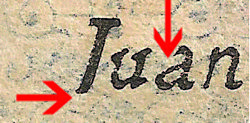
Position 1
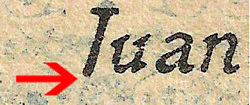
Position 2
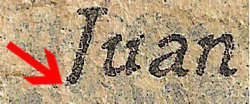
Position 3
This plate wear is found throughout the remaining settings in this series. With this exception, the positions are again as described above, with offset numbering patterns as follows.
Position 1 (top row): 7101-7200, 7401-7500.
Position 2 (middle row): 7201-7300, 7501-7600.
Position 3 (bottom row): 7301-7400, 7601-7700.
The third setting consists of one run with a single row of notes in order to adjust for the offset numbering of the second setting. This is the only time that mountain seal type 2 appears on the 5 Pesos Series 2 notes.
Position 1 (top row): mountain seal type 2, large eagle seal (broken ‘C’), thick block ‘No.’, and serial numbering pattern 7701-7800.
| Lettering | Mountain seal Type |
State seal Type | |
| Top row | Thick Block | 2 | Large - broken 'C' |
The fourth setting finally resumed the normal numbering pattern. There were 24 runs of 100 sheets with three positions each for a total of 7,200 notes.
Position 1 (top row): mountain seal type 3, large eagle seal (broken ‘C’), thick block ‘No.’, and serial numbering pattern 7801-7900, 8101-8200 …14701-14800.
Position 2 (middle row): mountain seal type 5, large eagle seal (normal ‘C’), thin block ‘No.’, and serial numbering pattern 7901-8000, 8201-8300 …14801-14900.
Position 3 (bottom row): mountain seal type 4, small eagle seal (with spot), thick fancy ‘No.’, and serial numbering pattern 8001-8100, 8301-8400 …14901-15000.
A replacement note was printed for note 12340 which presumably was defective. It was printed in position 1, as the original would have been, but the mountain seal used was type 1, and it was not used until the following two series. Also, the numbering device was the thick fancy ‘No.’ normally found in position 2, instead of the thick block ‘No.’ used in position 1.
Third series
As was the case with Series 2, the printers found maintaining a consistent serial numbering pattern challenging. Everything started well with the first setting of 16 runs of 100 sheets with three positions each for a total of 4,800 notes. The characteristics of the backs are the same as for Series 2.
Position 1 (top row): mountain seal type 4, large eagle seal (broken ‘C’), thick block ‘No.’, and serial numbering pattern 1-100, 301-400 …4501-4600.
Position 2 (middle row): mountain seal type 1, large eagle seal (normal ‘C’), thin fancy ‘No.’, and serial numbering pattern 101-200, 401-500 …4601-4700.
Position 3 (bottom row): mountain seal type 2, small eagle seal (with spot), thin block ‘No.’, and serial numbering pattern 201-300, 501-600 …4701-4800.
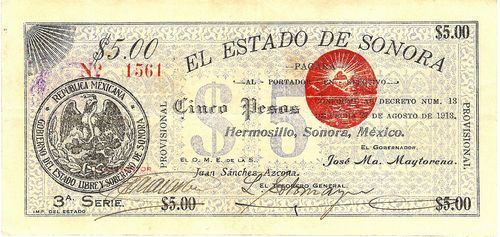 M3816c $5 El Estado de Sonora - 3rd Series
M3816c $5 El Estado de Sonora - 3rd Series
Position 1
 Position 2
Position 2
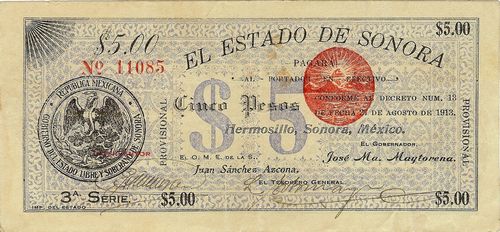 Position 3
Position 3
| Lettering | Mountain seal Type |
State seal Type | |
| Top row | Thick Block | 4 | Large - broken 'C' |
| Middle row | Thin Fancy | 1 | Large - normal C' |
| Bottom row | Thin Block | 2 | Small - with spot |
Problems arose on the second setting, when printing resumed beginning with number 4901 instead of 4801. That meant that once again there was a shifted numbering pattern, this time for only three runs of 100 sheets with three positions each for a total of 900 notes. The backs of the notes are the same as the first setting.
Position 1 (top row): mountain seal type 4, large eagle seal (broken ‘C’), thick block ‘No.’, and serial numbering pattern 4901-5000, 5201-5300, 5501-5600.
Position 2 (middle row): mountain seal type 1, large eagle seal (normal ‘C’), thin fancy ‘No.’, and serial numbering pattern 5001-5100, 5301-5400, 5601-5700.
Position 3 (bottom row): mountain seal type 2, small eagle seal (with spot), thin block ‘No.’, and serial numbering pattern 5101-5200, 5401-5500, 5701-5800.
The unusual third setting is one adjustment run of 300 notes. It inserts the previously omitted serial numbers, 4801-4900, on the bottom row and sets the stage to correct the numbering pattern in the fourth setting.
Position 1 (top row): mountain seal type 4, large eagle seal (broken ‘C’), thick block ‘No.’, and serial numbering pattern 5801-5900.
Position 2 (middle row): mountain seal type 1, large eagle seal (normal ‘C’), thin fancy ‘No.’, and serial numbering pattern 5901-6000.
Position 3 (bottom row): mountain seal type 2, small eagle seal (with spot), thin block ‘No.’, and the missing serial numbers 4801-4900.
The fourth setting resumed the normal numbering pattern for 30 runs of 100 sheets with three positions each for the final 9,000 notes.
Position 1 (top row): mountain seal type 4, large eagle seal (broken ‘C’), thick block ‘No.’, and serial numbering pattern 6001-6100, 6301-6400 …14701-14800.
Position 2 (middle row): mountain seal type 1, large eagle seal (normal ‘C’), thin fancy ‘No.’, and serial numbering pattern 6101-6200, 6401-6500 …14801-14900.
Position 3 (bottom row): mountain seal type 2, small eagle seal (spot below ‘Y’), thin block ‘No.’, and serial numbering pattern 6201-6300, 6501-6600 …14901-15000.
Fourth series
There are no errors in applying a uniform numbering pattern throughout what was probably a single continuous printing of a single setting, 50 runs of 100 sheets with three positions each for 15,000 notes. There are, however, many instances of extreme over-inking of the mountain seals.
The characteristics of the backs of the notes are the same as for the Third Series.
Position 1 (top row): mountain seal type 4, large eagle seal (broken ‘C’), thick block ‘No.’, and serial numbering pattern 1-100, 301-400 …14701-14800.
Position 2 (middle row): mountain seal type 1, large eagle seal (normal ‘C’), thin fancy ‘No.’, and serial numbering pattern 101-200, 401-500 …14801-14900.
Position 3 (bottom row): mountain seal type 2, small eagle seal (with spot), thin block ‘No.’, and serial numbering pattern 201-300, 501-600 …14901-15000.
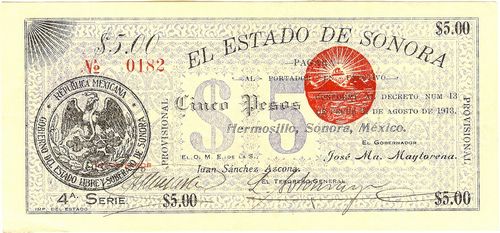 M3816d $5 El Estado de Sonora - 4th Series
M3816d $5 El Estado de Sonora - 4th Series
Position 1
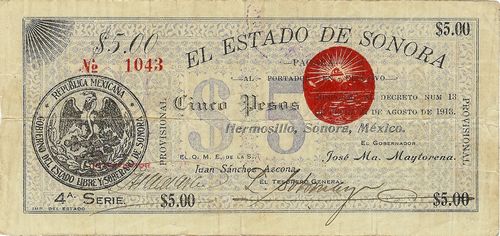 Position 2
Position 2
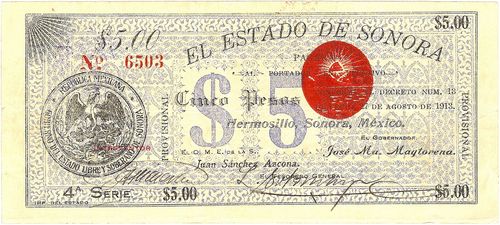 Position 3
Position 3
| Lettering | Mountain seal Type |
State seal Type | |
| Top row | Thick Block | 4 | Large - broken 'C' |
| Middle row | Thin Fancy | 1 | Large - normal 'C' |
| Bottom row | Thin Block | 2 | Small - with spot |
Remainders are known for this issue.

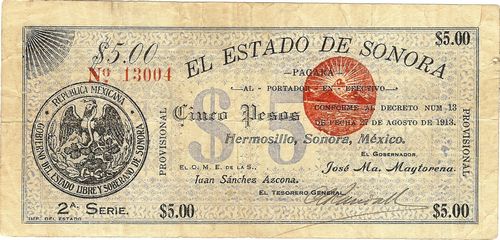 Position 2
Position 2